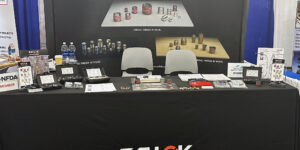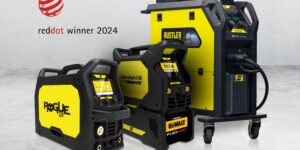Hydraulic Presses: Do your Homework
Here is a quick primer on how to purchase the best hydraulic press solution for your application and what factors to consider to avoid any pitfalls.
Posted: September 5, 2008
Today's hydraulic presses are faster, more reliable than ever and can do a wide variety of jobs within their tonnage range to provide excellent versatility. These presses are also uncomplicated and can have significant cost advantages over mechanical presses of comparable sizes.
Moving parts are few and they are fully lubricated in a flow of pressurized oil. These parts are usually standard, affordable, off-the-shelf components and are also relatively easy to replace. All of this equates to more uptime and lower maintenance costs. Hydraulic presses also provide easy tonnage adjustment and more tonnage control throughout the press stroke ? which expands your application possibilities. If you decide to go hydraulic, here are some key factors to consider when selecting and buying your press.
SELECTING YOUR PRESS TONNAGE
One of the first things to consider when purchasing a hydraulic press is selecting the tonnage. Is the tonnage required to do a job the same for a hydraulic press as it is for a mechanical press? The answer is yes. There is no real difference. The same formulae are used to determine tonnage for both types of presses. The tooling is usually interchangeable. There may be certain applications such as deep drawing where the full power stroke characteristic of a hydraulic press reduces the tonnage, but there are no known instances where using a hydraulic press requires more tonnage.
Selecting press tonnage in the typical press room is often little more than guesswork. If, for example, a job is successful on a 100-ton mechanical press, it tends to stay there for the life of that job. The job may never have been tried at 75 tons or at 50 tons. With a hydraulic press, however, you can adjust tonnage quickly and easily, tuning the press to precisely the right tonnage for each specific job.
? Generally speaking, to compute tonnage requirements when pressure per square inch (psi) is known:
? psi x area of work/2000 =
? 2 tons of ram force required
? Example: Where it is known that 100 psi is needed to do a job on a 5 in x 8 in wide piece, then
? 100 x 5 in x 8 in/2000 = 2 tons
On a press fit, to determine the force required to press fit two round pieces together such as a shaft pressed into a bushing, use the following formula:
? F = D x π x L x I x P/2
? Where: F = force required in tons
? D = diameter of the part to be pressed in inches
? L = length of part to be pressed in inches (Note: the length of the interference fit only.)
? I = interference in inches (usually .002 in to .006 in)
? P = pressure factor (see table)
When punching, a quick guide to determine tonnage requirements for punching steel is:
? Diameter x thickness x 80 = tons
? Where: 80 is constant for steel. Use 65 for brass.
? Example: A 3 in hole punched through .250 in stock:
? 3 in x .250 in x 80 = 60 tons
For noncircular holes, instead of the diameter, use 1/3 of the total length of cut. Example: A 4 in x 6 in rectangular hole in .250 in stock: (4 in + 6 in + 4 in + 6 in/3) x .250 in x 80 = 133.3 tons
When deep drawing, these calculations can be complex because the press, dies, material, radius, and part shape all have bearing. For drawing round shells, the following formula is a simple guide:
? C x T x Ts = tons
? Where: C = circumference of the finished part;
? T = material thickness in inches
? Ts = tensile strength of the material
? Example: To draw a 5 in diameter cup of .040 in stock with a tensile strength of 46,000 psi would require the following tonnage:
? (5 x 3.1416) x .040 x (46000/2000) = 14.44 tons
? (A 20-ton press would be recommended)
For straightening, the pressure required to straighten a piece of metal depends on its shape. Below is an approximate formula with a further definition for different shapes:
? F = 6UZ/2000L
? Where: F is the ram force in tons
? 6 is a constant
? U is ultimate strength of the material in psi
? Z is the section modulus (see below)
? L is the distance between the straightening blocks in inches.
Example: A 2 in diameter shaft, 18 in between the blocks, 100,000 psi ultimate strength.
HOW THE PRESS AFFECTS THE JOB
Once the tonnage question is settled, it's time to determine the effect of the stroke on the work. Is it the same as with a mechanical press? The answer, again, is yes in most cases. There are some specific limitations. For example, drop hammers and some mechanical presses seem to do a better job on soft jewelry pieces and impact jobs. The coining action seems sharper if the impact is available.
In deep drawing, however, the full power stroke of a hydraulic press produces significantly better results. Otherwise, there are very few examples where the application of 100 tons of hydraulic force produces any significant difference in the character of the part given the same tooling.
Shear in the dies will reduce blanking tonnage for hydraulic presses in the same way it does for mechanical presses.
WHAT TYPE OF PRESS IS BEST FOR THE APPLICATION
Now it's time to determine which type of hydraulic press is best for your particular application.
Open-gap presses provide easy access from three sides. Four-column presses ensure even pressure distribution. Straight-side presses offer the rigidity required for off-center loading in progressive die applications. One important thing to keep in mind: The more critical the work and the more demanding the tolerances, the greater the reserve tonnage capacity should be.
Once the basics are determined, the next thing to consider is options. Most hydraulic press builders offer a wide array of accessories that commonly include:
? Distance reversal limit switches
? Pressure reversal hydraulic switches
? Automatic (continuous) cycling
? Dwell timers
? Sliding bolsters and rotary index tables
? Die cushions
? Ejection cylinders or knockouts
? Electronic light curtains and other devices
? Touch screen controls
? Servo system feedback for precise, consistent, repeatable stroke control
Next, you must determine what type of quality you require to get the job done. Quality can vary greatly from press to press. There are light-duty presses that are quite capable of "spanking" the work momentarily and reversing, and there are heavy-duty machines designed for general purpose metalworking applications. A few construction points can be used to compare one machine with another:
? Frame: Inspect the frame construction rigidity, bolster thickness, dimensional capacity, and other factors.
? Cylinder: What diameter is it? How is it constructed? Who makes it? How serviceable is it?
? Maximum system pressure: At what psi does the press develop full tonnage? The most common range for industrial presses is 1000 psi to 3000 psi.
? Horsepower: The duration, length, and speed of the pressing stroke determine the horsepower required. Compare horsepower ratings.
? Speed: Determine the speed each hydraulic press offers.
BUYER BEWARE
There are many potential pitfalls to take into account when selecting your hydraulic press. Specific things to watch out for include:
? Speed. There are no hydraulic presses today that are as fast as the fastest mechanical presses. If speed is the sole requirement, the application is fixed and the material feed stroke is relatively short, the mechanical press remains the best selection.
? Stroke depth. If a limit switch is used to determine the bottom, the stroke depth is not likely to be controlled much closer than .020 in. Many hydraulic presses can be set to reverse at a preselected pressure, which usually results in uniform parts. Generally, if absolute stroke depth accuracy is required, "kiss" blocks must be provided in the tooling.
? Automatic feeding equipment. Hydraulic presses require some external or auxiliary power to feed stock. The feeder must have its own power, and must be integrated with the press control system. There is, however, an increasing selection of self-powered feeding systems available such as roll feeds, hitch feeds, and air feeds.
? Shock after breakthrough in blanking. Both mechanical and hydraulic presses experience this problem. But the hydraulic system of a hydraulic press must also be isolated from the shock associated with decompression. If the hydraulic system does not contain an anti-shock feature, this shock can affect the lines and fittings.
The nearby schematic illustrates a typical hydraulic press decompression control. When the directional control valve (1) is activated to extend the cylinder, fluid enters the cylinder (5) via the check valve (2). Pressurization of the cylinder during extension closes the pressure reducing valve (3), so that when the directional control valve (1) is activated to retract the cylinder (5) the compressed volume of fluid is metered across the orifice (4).
When pressure upstream of the orifice (4) falls below the setting of the pressure reducing valve (3) the remaining fluid in the cylinder flows back to tank across the pressure reducing valve (3). The sequence valve (6) prevents pressurization of the rod side of the cylinder before the piston side has decompressed and the pressure reducing valve (3) has opened.
DO THE HOMEWORK
As with any major purchase, it's important to do your homework. Once you determine you want to go hydraulic, take the time to consider the issues reviewed above to make sure you get the best solution for your specific application.
Furthermore, strongly consider selecting a vendor with which you can easily partner. Key things to look for regarding a vendor include excellent communication and support, engineering expertise and custom-build capability, all of which inevitably provide press success.
Greenerd Press and Machine Co., Inc., 41 Crown Street, P.O. Box 886, Nashua, NH 03061, 603-889-4101, Fax: 603-889-7601, www.greenerd.com.









